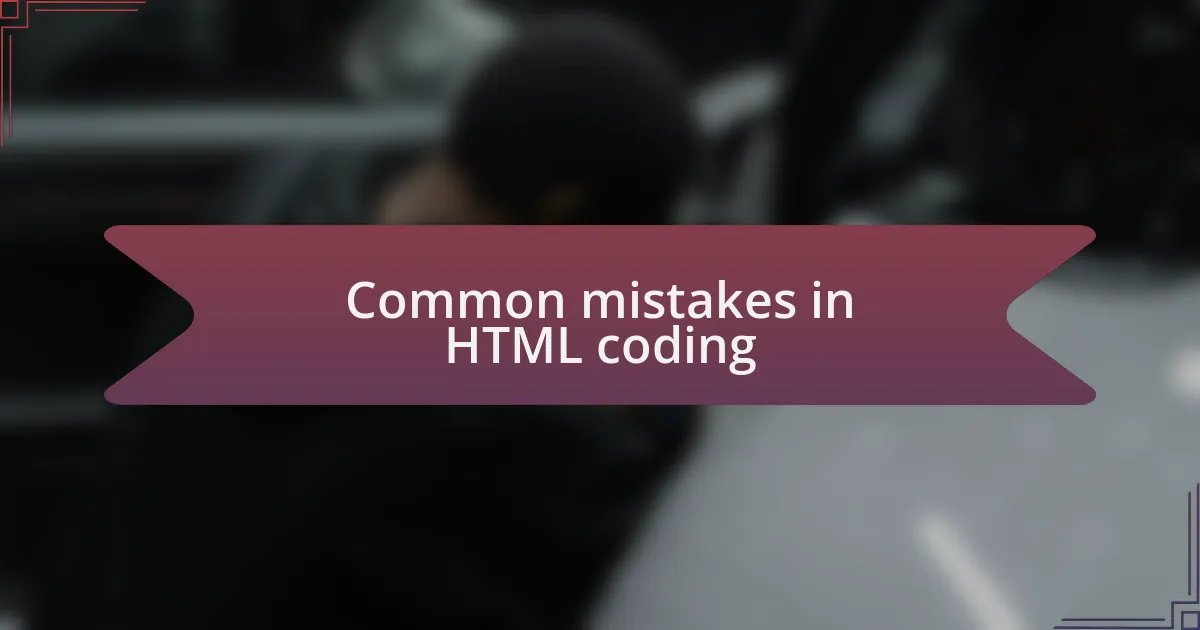Key takeaways:
- Clean HTML enhances usability, readability, and maintenance through the use of semantic tags and proper formatting.
- Common mistakes, such as failing to close tags and using inline styles excessively, can negatively impact code quality and user experience.
- Structuring HTML with clear hierarchy and semantic elements improves accessibility and SEO.
- Utilizing tools like W3C Markup Validation Service and browser developer tools can significantly aid in debugging and validating HTML code.

Understanding clean HTML principles
When I first started diving into web development, I quickly realized that clean HTML is crucial for usability. Keeping your code organized not only helps future-proof your projects but makes it incredibly easier for others (and yourself) to read and maintain it later. Have you ever stared at a tangled mess of code, feeling overwhelmed? I think we can all relate to that feeling, and it’s where the principle of clearly structured HTML really shines.
One key aspect of clean HTML is proper use of semantic tags. By using elements like <header>, <nav>, and <article>, you create a clearer picture of your page’s structure. I remember my first project where I used generic <div> tags everywhere; it was like trying to read a book written in riddles. When I transitioned to semantic elements, the clarity was refreshing. Have you noticed how much more intuitive a page becomes when it’s structured well?
Another principle that I’ve found valuable is the importance of indentation and spacing. This might seem minor, but well-indented code brings a sort of visual harmony that makes the whole document feel more coherent. I once neglected this and learned the hard way that even the small details matter. By taking the time to format your HTML neatly, you cultivate not only a better coding environment but also cultivate pride in your work. After all, don’t we all want our code to reflect our best efforts?

Common mistakes in HTML coding
Common mistakes in HTML coding can have a significant impact on both readability and functionality. One common pitfall is failing to close tags properly. I remember a time when I overlooked a missing closing tag in my project, and it felt like I was chasing a ghost. The layout kept breaking unexpectedly, and it took hours to trace back to that small oversight. It’s a good reminder that even tiny details can create big headaches.
Another mistake I’ve encountered is using inline styles excessively. While it may seem convenient, embedding styles directly in HTML can lead to a tangled mess when managing larger projects. I once took this shortcut for a time-sensitive task, and the result was chaotic. Later, I had to rewrite the entire style sheet to keep it manageable. Have you ever faced a similar situation where a quick fix turned into a long-term issue? Opting for external or internal CSS not only keeps code cleaner but also separates structure from presentation, enhancing both readability and maintainability.
Lastly, not leveraging the power of alt attributes in images is a big oversight. In my early days, I often left these blank, thinking it wouldn’t matter much. It wasn’t until someone pointed out how vital they were for accessibility that I understood the implications. Alt text improves user experience for those relying on screen readers and enhances SEO. It’s a small addition that carries significant weight. Have you considered how a little extra effort in this area can make a difference for your users?

Tips for structuring your HTML
When it comes to structuring your HTML, I can’t stress enough the importance of clear hierarchy. Using headings correctly—like H1 for titles, followed by H2 for main sections—helps create an organized structure. I once built a page where I skipped some heading levels out of convenience, and I quickly realized it made navigating the content feel disjointed. Have you ever felt lost while reading a webpage? Proper heading structure can guide users, making your content easily digestible.
Another tip I’ve learned from experience is to keep your elements semantically correct. Using tags like